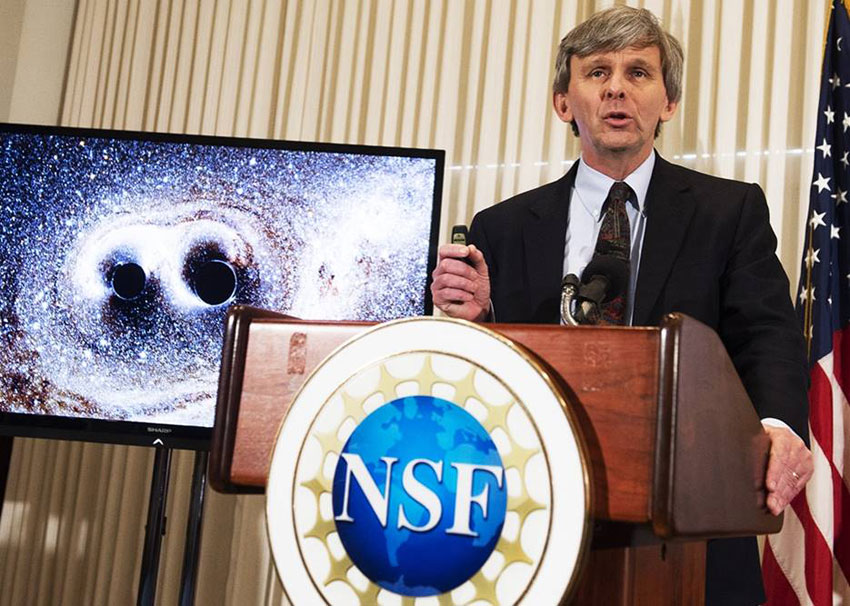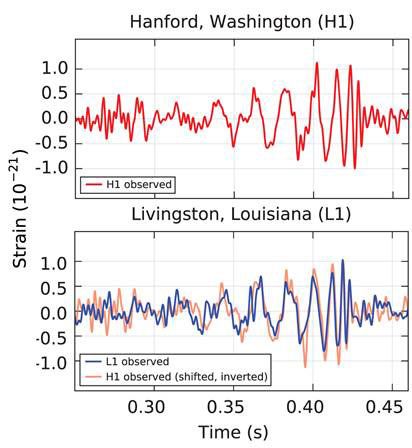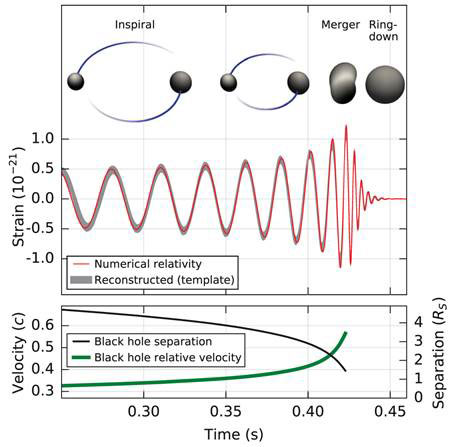More than half a century of dedicated effort to build the most sensitive detectors of gravitational waves has finally paid off, but its presumed source remains unconvincing Dr. Mae-Wan Ho

“We have detected gravitational waves. We did it”, said David Reitz, executive director of the Laser Interferometer Gravitational-Wave Observatory (LIGO) at an emotional National Science Foundation press conference in Washington [1].
Gravitational waves have a lot in common with electromagnetic waves, but also distinct, for they are “ripples of spacetime itself” [2] and extremely weak and difficult to detect.
Tim Radford of the Guardian wrote [1]: “The announcement is the climax of a century of speculation, 50 years of trial and error, and 25 years perfecting a set of instruments so sensitive they could identify a distortion in spacetime a [ten-]thousandth the diameter of one atomic nucleus [i.e., ~10-19m] across a 4 km strip of laser beam and mirror.”
The latest effort involves a consortium of more than a thousand scientists from 133 institutions in 18 countries around the world. The detailed results and analysis are published in Physical Review Letters [3].
Albert Einstein (1879-1955) predicted the existence of gravitational waves a hundred years ago in 1916 [4] the year after his final formulation of the field equations of general relativity. This makes the announcement all the more significant.
It was also in 1916 that German physicist Karl Schwarzschild (1873-1916) published a solution for Einstein’s field equations [5] that decades later became understood as a model for a black hole and was then generalized to rotating black holes. Further theoretical work since the 1970s has enabled modelling of two black holes merging and accurate predictions of their gravitational wave forms (reviewed in [3]).
Attempts to detect gravitational waves began with American physicist Joseph Weber (1919-2000) in the 1960s, who initiated a network of cryogenic resonant mass detectors. Interferometric detectors, first suggested in the 1960s and 1970s, led to the present generations of laser interferometer detectors. By the early 2000s, a set of laser interferometer detectors was built, including TAMA 300 in Japan, GEO 600 in Germany, LIGO in the United States, and Virgo in Italy. Combinations of these detectors made joint observations from 2002 through 2011. In 2015, Advance LIGO became the first of a significantly more sensitive network of advanced detectors. And this has brought success.
On 14 September 2015 at 09:50:45 UTC (Coordinated Universal Time, commonly used across the world), the LIGO Hanford in Washington and Livingston in Louisiana 1 900 miles apart registered the same gravitational wave signal with a delay of ~10 ms in the Livingston detector (Figure 1). The signal was filtered to remove noise. The two traces are almost identical after adjusting for the delay and position.
It was a very lucky break. At the time, only the LIGO detectors were observing. The Virgo was being upgraded, and GEO 600 though operating was not observing, and not sensitive enough to detect this event in any case.

Figure 1 Signal of gravitational waves arriving at two LIGO detectors 10 ms apart
Figure 2 shows the estimated gravitational-wave strain amplitude of the signal projected onto H1 in the full bandwidth of the waveforms without the filtering used for Figure 1, together with the model of the black holes first spiralling around each other, coming closer, accelerating, then merging into one and ‘ringing down’. This all happens at fractions of the speed of light and takes less than 0.45s.

Figure 2 Model of two black holes merging and projected waveforms of H1
The two Advanced LIGO detectors are identical. Each is a Michelson interferometer that measures gravitational-wave strain as a difference in length of its orthogonal arms. The interferometer is set up in a vacuum chamber cocooned and well isolated inside steel and concrete, the orthogonal arms each 4 km long. A laser beam is sent via a beam splitter simultaneously down the two arms and reflected back at the end. When there is no disturbance, the two beams recombine at the beam splitter and cancel each other out, so in principle no light goes to the detector. (In reality a constant level of noise remains.) A gravitational wave alters the arm lengths and hence introduces a phase difference between the two light fields returning to the beam splitter, causing an optical signal to be transmitted to the photodetector. This basic design is modified to increase sensitivity 1.5 million-fold and optimized for the extraction of the gravitational-wave signal by broadening the bandwidth of the arm cavities. In their most sensitive band, 100-300 Hz, the current LIGO detectors are 3 to 5 times more sensitive to strain than the initial LIGO, and at lower frequencies, the improvements are even better.
To monitor environmental disturbances and their influence on the detectors, each observation site is equipped with an array of sensors: seismometers, accelerometers, microphones, magnetometers, radio receivers, weather sensors, ac-power line monitors, and a cosmic-ray detector. None of the environmental sensors recorded any disturbances that looked anything like the gravitational signal, and all environmental fluctuations during the second that contained the signal were too small to account for more than 6 % of its strain amplitude.
The event was identified with two different types of computer searches. The first recover signals from the merging of two compact astronomical objects (such as black holes), using optimal matched filtering with waveforms predicted by general relativity. The other search targets a broad range of generic transient signals with minimal assumptions about waveforms. The second type of search picked out the event as the strongest in a large ream of data, corresponding to a probability <2 x 10-6 of observing one or more noise events as strong, and equivalent to 4.6 s (standard deviations). The first type of search again picked out the event as the strongest by far, corresponding to a false alarm probability of <2 x 10-7 and 5.1 s.
To refine estimates for the sources of the gravitational waves signal, general relativity based models were used. This gave the mass of one black hole as ~36 solar mass (1 solar mass is equal to 1.989 x 1030 kg), the other ~29 solar mass, and the final black hole ~62 solar mass. The event occurred 1.34 billion light years from Earth. Using the fits to numerical simulations of binary black hole mergers recently published in the literature, the estimated total energy radiated in the gravitational waves is ~3solar mass x c2 = 5.37 x 1047 J, an enormous amount of energy. The system reached a peak gravitational-wave luminosity of 200 solar mass x c2/s, = 3.98 x 1048 J/s or 3.98 x 1048 W, an output ~50 times that of the whole visible universe [2].
And where exactly did the gravitational waves come from? Because there were two detectors and a time delay between the two, it was possible to work out roughly where the merging black holes are located. It is with 90 % probability within a large crescent in the Southern sky [6].
The detection of gravitational waves is convincing and a great triumph of exquisite engineering and instrumentation design. But it also reminds us how extremely weak gravitational effects are compared to electromagnetic effects. It takes the release of mass-energy equivalent to 3 Suns and a peak power output 50 times that of the visible universe for the gravitational waves to be detectable. In contrast, electromagnetic effects in the entire spectrum due to electric plasma interactions are easily detected with an array of Earth-bound, satellite and other space-borne telescopes (see [7] Electric Plasma Universe Arrives and other articles in the series, SiS 68). Einstein and his followers are right about the existence of gravity and gravitational waves, but they remain mistaken that gravity alone can create the universe.
Furthermore, black holes themselves have never been directly observed. Instead, numerous black hole candidates have been identified through electromagnetic observations, such as jets and strong magnetic fields; whereas supermagnetic fields can be easily created without the help of black holes in the electric plasma universe (see [8] Supermagnetic Field or Supermassive Black Hole, SiS 67). Black hole collisions or mergers have not yet been observed, not even through their electromagnetic manifestations, which would no doubt be spectacular. At the press conference in Washington, an artist’s impression of the colliding/merging black holes was presented for the benefit of the mass media [1]. In truth, what we have is a set of sophisticated numerical calculation software fine-tuned to reproducing observations on the assumption that black holes are responsible for electromagnetic effects.
Article first published 22/02/16
Comments are now closed for this article
There are 1 comments on this article.
Rory Short Comment left 25th February 2016 02:02:09
I wonder whether the pre--occupation with gravity is because gravity is palpably significant in our lives whereas electromagnetic radiation is not?